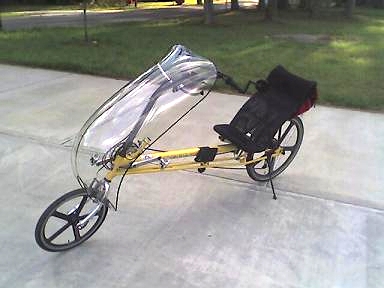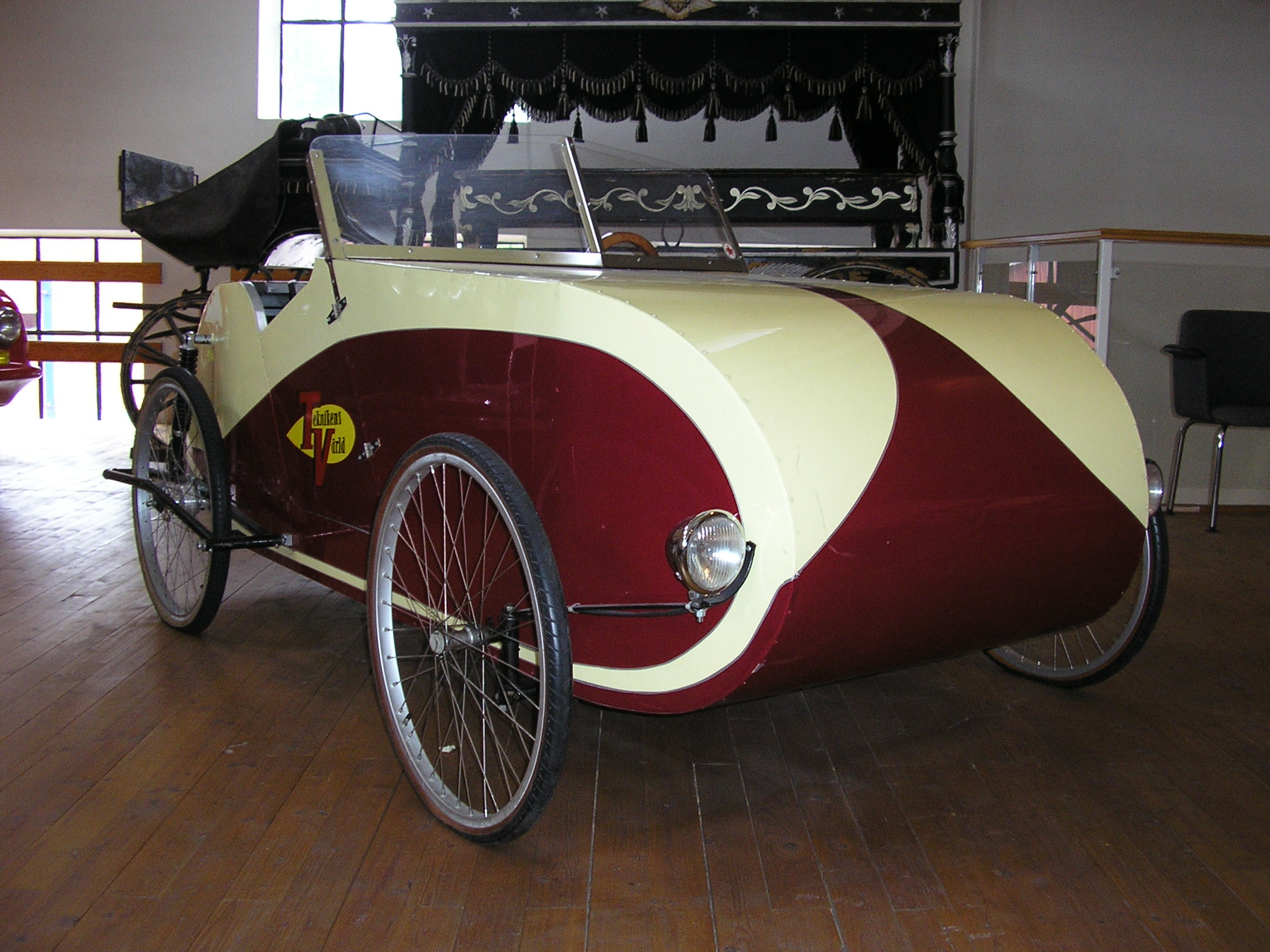|
Velocar
Velocar was the name given to velomobiles made in the 1930s and 1940s by Mochet et Cie of Puteaux, France and colloquially to the company's recumbent bicycles. was the inventive maker of lightweight powered cyclecars (Le P'tit Auto) and pedal-powered cars (quadricycles), mainly two-seaters, built on a tubular-steel chassis with bicycle-sized wheels, variable gears, and aerodynamic bodywork, in effect a faired-in "sociable". The popularity of the little cars declined in the late 1930s as cheaper, powered cars became available, only to rise rapidly when petrol became almost unobtainable during World War II, 1939–1945. However, Mochet's stroke of genius was to make what was the first performance recumbent bicycle, or ''vélo couché'', using a design that was based on half of his four-wheeled Velocar. This machine, called by the factory the "Velo-Velocar", or "V-V" for short, broke many world cycling records in 1933. Although Mochet had verified with the UCI and the UVF that ... [...More Info...] [...Related Items...] OR: [Wikipedia] [Google] [Baidu] |
Recumbent Bicycle
A recumbent bicycle is a bicycle that places the rider in a laid-back reclining position. Most recumbent riders choose this type of design for ergonomic reasons: the rider's weight is distributed comfortably over a larger area, supported by back and buttocks. On a traditional upright bicycle, the body weight rests entirely on a small portion of the Tuberosity of the ischium, sitting bones, the feet, and the hands. Most recumbent models also have an aerodynamics, aerodynamic advantage; the reclined, legs-forward position of the rider's body presents a smaller frontal profile. A recumbent holds the world speed record for a bicycle, and they were banned from racing under the Union Cycliste Internationale (UCI) in 1934, and now race under the banner of the World Human Powered Vehicle Association (WHPVA) and International Human Powered Vehicle Association (IHPVA). Recumbents are available in a wide range of configurations, including: long to short wheelbase; large, small, or a mix ... [...More Info...] [...Related Items...] OR: [Wikipedia] [Google] [Baidu] |
Recumbent Bicycle
A recumbent bicycle is a bicycle that places the rider in a laid-back reclining position. Most recumbent riders choose this type of design for ergonomic reasons: the rider's weight is distributed comfortably over a larger area, supported by back and buttocks. On a traditional upright bicycle, the body weight rests entirely on a small portion of the Tuberosity of the ischium, sitting bones, the feet, and the hands. Most recumbent models also have an aerodynamics, aerodynamic advantage; the reclined, legs-forward position of the rider's body presents a smaller frontal profile. A recumbent holds the world speed record for a bicycle, and they were banned from racing under the Union Cycliste Internationale (UCI) in 1934, and now race under the banner of the World Human Powered Vehicle Association (WHPVA) and International Human Powered Vehicle Association (IHPVA). Recumbents are available in a wide range of configurations, including: long to short wheelbase; large, small, or a mix ... [...More Info...] [...Related Items...] OR: [Wikipedia] [Google] [Baidu] |
Velocar
Velocar was the name given to velomobiles made in the 1930s and 1940s by Mochet et Cie of Puteaux, France and colloquially to the company's recumbent bicycles. was the inventive maker of lightweight powered cyclecars (Le P'tit Auto) and pedal-powered cars (quadricycles), mainly two-seaters, built on a tubular-steel chassis with bicycle-sized wheels, variable gears, and aerodynamic bodywork, in effect a faired-in "sociable". The popularity of the little cars declined in the late 1930s as cheaper, powered cars became available, only to rise rapidly when petrol became almost unobtainable during World War II, 1939–1945. However, Mochet's stroke of genius was to make what was the first performance recumbent bicycle, or ''vélo couché'', using a design that was based on half of his four-wheeled Velocar. This machine, called by the factory the "Velo-Velocar", or "V-V" for short, broke many world cycling records in 1933. Although Mochet had verified with the UCI and the UVF that ... [...More Info...] [...Related Items...] OR: [Wikipedia] [Google] [Baidu] |
Velomobile
A velomobile (); velomobiel, velo, or bicycle car is a human-powered vehicle (HPV) enclosed for aerodynamic advantage and/or protection from weather and collisions. Velomobiles are similar to recumbent bicycles, pedal go-karts and tricycles, but with a full fairing (aerodynamic or weather protective shell) and are not to be confused with purpose-built mobiles for racing or speed records fully faired vehicles with two wheels, generally called streamliners. Streamliners have set many speed and distance records. Though fast in their own right, velomobiles are considered much more suitable for the street than two-wheeled streamliners. Using three or more wheels can have advantages for everyday use, including the ability to stop and start unaided, better stability, cross-wind handling, etc., though there are arguments made that the multiple track machines (three or more wheels) have aerodynamic disadvantages due to the drag of the extra wheels and the surface contact points. In pr ... [...More Info...] [...Related Items...] OR: [Wikipedia] [Google] [Baidu] |
Velomobile
A velomobile (); velomobiel, velo, or bicycle car is a human-powered vehicle (HPV) enclosed for aerodynamic advantage and/or protection from weather and collisions. Velomobiles are similar to recumbent bicycles, pedal go-karts and tricycles, but with a full fairing (aerodynamic or weather protective shell) and are not to be confused with purpose-built mobiles for racing or speed records fully faired vehicles with two wheels, generally called streamliners. Streamliners have set many speed and distance records. Though fast in their own right, velomobiles are considered much more suitable for the street than two-wheeled streamliners. Using three or more wheels can have advantages for everyday use, including the ability to stop and start unaided, better stability, cross-wind handling, etc., though there are arguments made that the multiple track machines (three or more wheels) have aerodynamic disadvantages due to the drag of the extra wheels and the surface contact points. In pr ... [...More Info...] [...Related Items...] OR: [Wikipedia] [Google] [Baidu] |
Mochet
Georges Mochet began to produce cycle-cars at his, now-demolished, premises at 68, Rue Roque-de-Fillol at Puteaux in approximately 1946 and by about 1952 had progressed to more modern looking two seater micro-cars and powered two-wheelers. In 1958, with approximately 3,000 vehicles manufactured, production ended. Georges had inherited the business from his father, (1880–1934) under whose leadership it had, after the First World War, produced children's’ pedal cars and, between 1924 and 1934, the ' Vélocar' lightweight, pedal-powered, cycle-car. In 1934, the firm's revolutionary 'Vélo-Vélocar' recumbent bicycles, ridden to record-breaking speeds by Francis Faure, were banned from cycling competitions by the Union Cycliste Internationale. Charles Mochet died soon after. The continuation of recumbent cycle production and of the cycle-cars, popular in occupied, no-petrol France, and the subsequent switch to micro-cars under Georges after the Second World War was therefor ... [...More Info...] [...Related Items...] OR: [Wikipedia] [Google] [Baidu] |
Francis Faure
Francis Faure was a French bicycle racer who captured the world hour record in July 1933 on a Vélocar. This prompted the Union Cycliste Internationale (UCI) to restrict bicycle designs for all future competitions. Early life Francis was brother of Benoît Faure and Eugène Faure. 1933 On July 7, 1933, Faure rode a Vélocar developed by Charles Mochet in the Vélodrome d'Hiver in Paris, and he beat the hour record of 44.247 km set by Oscar Egg on August 18, 1914, by 0.808 km. At the time, Faure was considered a "second-rate" cyclist and was not Mochet's first choice. The unfaired, or "stock" recumbent record stood until it was broken in 2007 by an "unclassified" racer Sean Costin, who covered 48.80 km (28.46 mi) on the 382m outdoor concrete velodrome in Northbrook, Illinois. He rode a recumbent made by the Polish manufacturer Velokraft (model name NoCom), which he converted to a fixed-gear for the indoor event. 1938 In 1938, Faure rode an updated, streamli ... [...More Info...] [...Related Items...] OR: [Wikipedia] [Google] [Baidu] |
Model Car
A model car, or toy car, is a miniature representation of an automobile. Other miniature motor vehicles, such as trucks, buses, or even ATVs, etc. are often included in this general category. Because many miniature vehicles were originally aimed at children as playthings, there is no precise difference between a model car and a toy car, yet the word 'model' implies either assembly required or the accurate rendering of an actual vehicle at smaller scale. The kit building hobby became popular through the 1950s, while the collecting of miniatures by adults started to pick up momentum around 1970. Precision-detailed miniatures made specifically for adults are a significant part of the market since the mid-1980s. The scope of the vehicles involved in the hobby, according to Louis Heilbroner Hertz author of ''The Complete Book of Building and Collecting Model Automobiles'', encompasses "ordinary or stock automobiles, racing cars ( hellip;, buses, trucks, specialized service vehicles ... [...More Info...] [...Related Items...] OR: [Wikipedia] [Google] [Baidu] |
Go-kart
A go-kart, also written as go-cart (often referred to as simply a kart), is a type of sports car, close wheeled car, open-wheel car or quadracycle. Go-karts come in all shapes and forms, from non-motorised models to high-performance Kart racing, racing karts. Karting is a type of racing in which a compact four-wheel unit called a go-kart is used. In the beginning, Art Ingels invented the first go-kart in Los Angeles in 1956. Etymology The exact origin of the term is unclear. One of the first appearances of the term is an 1885 painting by the Scottish artist Hugh Cameron (artist), Hugh Cameron RSA: "The Go-Cart". It is also unclear why the "C" was later changed to a "K". Non-motorised Gravity racers, in North America usually referred to as Soap Box Derby carts, are the simplest type of go-karts. They are propelled by gravity. Go-karts without motors (quadracycles) may also be propelled by bicycle pedals. Motorised Engines Traditionally, small Two-stroke engine, two-st ... [...More Info...] [...Related Items...] OR: [Wikipedia] [Google] [Baidu] |
World War II
World War II or the Second World War, often abbreviated as WWII or WW2, was a world war that lasted from 1939 to 1945. It involved the vast majority of the world's countries—including all of the great powers—forming two opposing military alliances: the Allies and the Axis powers. World War II was a total war that directly involved more than 100 million personnel from more than 30 countries. The major participants in the war threw their entire economic, industrial, and scientific capabilities behind the war effort, blurring the distinction between civilian and military resources. Aircraft played a major role in the conflict, enabling the strategic bombing of population centres and deploying the only two nuclear weapons ever used in war. World War II was by far the deadliest conflict in human history; it resulted in 70 to 85 million fatalities, mostly among civilians. Tens of millions died due to genocides (including the Holocaust), starvation, ma ... [...More Info...] [...Related Items...] OR: [Wikipedia] [Google] [Baidu] |
Union Cycliste Internationale
The ''Union Cycliste Internationale'' (UCI; ; en, International Cycling Union) is the world governing body for sports cycling and oversees international competitive cycling events. The UCI is based in Aigle, Switzerland. The UCI issues racing licenses to riders and enforces disciplinary rules, such as in matters of doping. The UCI also manages the classification of races and the points ranking system in various cycling disciplines including road and track cycling, mountain biking and BMX, for both men and women, amateur and professional. It also oversees the World Championships. After the 2022 Russian invasion of Ukraine, the UCI said that Russian and Belarusian teams are forbidden from competing in international events. It also stripped both Russia and Belarus of scheduled events. History UCI was founded in 1900 in Paris by the national cycling sports organisations of Belgium, the United States, France, Italy, and Switzerland. It replaced the International Cycling Associ ... [...More Info...] [...Related Items...] OR: [Wikipedia] [Google] [Baidu] |




.jpg)


